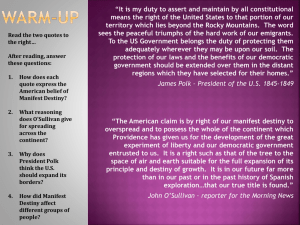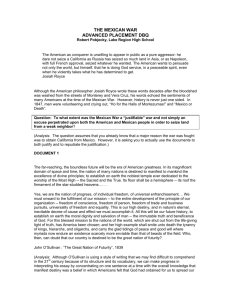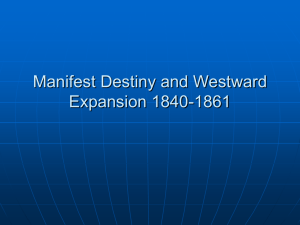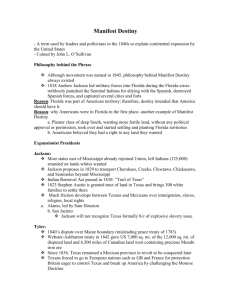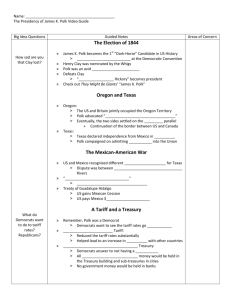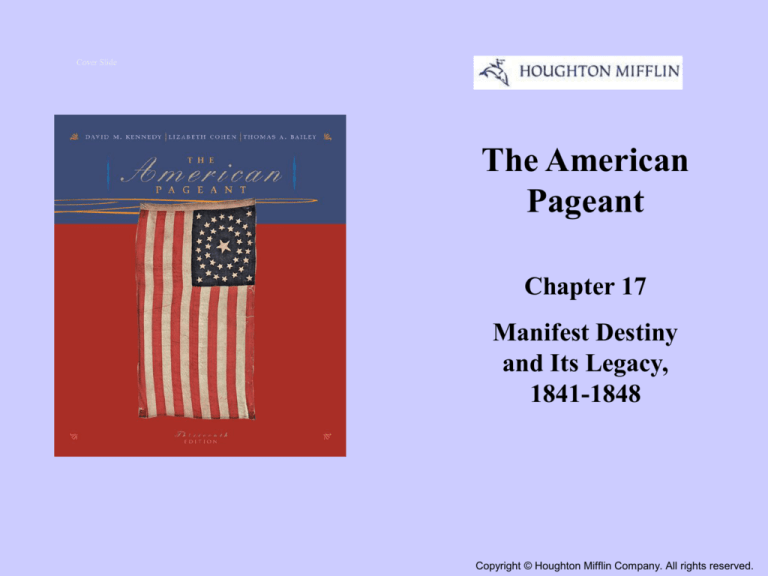
Cover Slide
The American
Pageant
Chapter 17
Manifest Destiny
and Its Legacy,
1841-1848
Copyright © Houghton Mifflin Company. All rights reserved.
Manifest Destiny
“Our manifest destiny is to overspread the continent
allotted by Providence for the free development of
our yearly multiplying millions.”
-John L. O’Sullivan,1845
HISTORICAL SIGNIFICANCE:
Americans believe it is their destiny to expand the US
borders to the Pacific.
1832: Black Hawk War
Chief Black Hawk leads Sauk and Fox nations as they fight
US expansion in Illinois. Sauk and Fox forced west of the
Mississippi. Gen. Winfield Scott leads US forces.
http://www.co.kane.il.us/History/section03.htm
Settlers and Native
Americans
1851: Fort Laramie Treaty
Cheyenne Arapaho, Sioux, and Crow agree to allow settlers to
move through the Great Plains.
US to pay the Nations and to respect their boundaries.
Frequently violated by US.
Tejas to Texas
•
•
•
•
“Lone Star State” stands alone
Mexico threatens to recapture it
Texas turns to France and Great Britain
Expansionists fear a return of European powers to the
Western Hemisphere/violation of the Monroe Doctrine
• Issue of slavery and war with Mexico delays annexation
• Joint resolution from Congress makes annexation possible
in 1845.
• Boundary of Texas still in dispute.
Fall of the Alamo by Robert Jenkins Onderdonk
Fall of the Alamo by Robert Jenkins Onderdonk
Although they were greatly outnumbered, Texas forces held off a siege at the Alamo
by the Mexican army under Antonio López de Santa Anna. The old mission's walls
were eventually breached, however, and the Texans were overcome in hand-to-hand
fighting. This painting is an artist's conception of the last moments of battle, before
the remaining Texans were finally defeated. (Friends of the Governor's Mansion)
Copyright © Houghton Mifflin Company. All rights reserved.
Map: Texas Revolution
Texas Revolution
This map shows troop movements and the major battles in the Texas Revolution, as well as the conflicting boundary claims
made by Texans and the Mexican government. The Battle of San Jacinto and the Treaty of Velasco ended the war, but the
Copyright © Houghton Mifflin Company. All rights reserved.
conflicting land claims continued when Mexico repudiated the treaty.
Map: Major Battles of the Texas Revolution, 1835-1836
Copyright © Houghton Mifflin Company. All rights reserved.
Major Battles of the Texas Revolution, 1835-1836
Sam Houston's victory at San Jacinto was the decisive action of the war and avenged the massacres at the Alamo and Goliad.
Polk and Dallas Flag
Polk and Dallas Flag
This campaign banner celebrating the candidacy of James K. Polk and George M.
Dallas on the Democratic ticket carries a subtle message conveying the party's
platform. Surrounding Polk's picture are twenty-five stars, one for each state in the
Union. Outside the corner box, a twenty-sixth star stands for Texas, which Polk
promised to annex. (Collection of David J. and Janet L. Frent)
Copyright © Houghton Mifflin Company. All rights reserved.
http://teachpol.tcnj.edu/amer_pol_hist/fi/00000096.htm
Map: The Election of 1844
The Election of 1844
The election of 1844 demonstrated one incontestable fact: the annexation of Texas had more national support than Clay had
realized. The surging popular sentiment for expansion that made the underdog Polk rather than Clay the man of the hour
reflected a growing conviction among the people that America's natural destiny was to expand into Texas and all the way to
Copyright © Houghton Mifflin Company. All rights reserved.
the Pacific Ocean.
Excerpt from Polk’s Inaugural Address
I regard the question of annexation as belonging exclusively to the
United States and Texas. They are independent powers competent to
contract, and foreign nations have no right to interfere with them or to
take exceptions to their reunion. Foreign powers do not seem to
appreciate the true character of our Government. Our Union is a
confederation of independent States, whose policy is peace with each
other and all the world. To enlarge its limits is to extend the
dominions of peace over additional territories and increasing millions.
The world has nothing to fear from military ambition in our
Government. …. Foreign powers should therefore look on the
annexation of Texas to the United States not as the conquest of a
nation seeking to extend her dominions by arms and violence, but as
the peaceful acquisition of a territory once her own, by adding another
member to our confederation, with the consent of that member,
thereby diminishing the chances of war and opening to them new and
ever-increasing markets for their products.
President Polk the Purposeful
Polk narrowly defeats Clay in 1844.
Polk is an Expansionist Democrat.
POLK’S FOUR GOALS:
1. Lower tariff
2. Restore an independent treasury
3. Settle dispute over Oregon
4. Acquire California
Did #3 & #4 contribute to war with Mexico?
http://www.vahistory.org/horse_film/image.php?file_id=13&size=large
Complete Explanation:
A comic scene anticipating a Whig victory
in the upcoming presidential election. The
date is 1845, after an election supposedly
decided on the Texas question, the tariff
issue, and Democratic identification with
Jacksonian policies. The artist ridicules
Democrat James K. Polk's advocacy of
the annexation of Texas as misguided
aggression. In addition, the title's use of
the phrase "Going to Texas,"
contemporary code for embezzling, may
be a swipe at the political spoils system
associated with the Democrats since the
Jackson administration. Incumbent
President John Tyler also comes under
attack for corruption.
The scene is outside the White House.
On a "Loco Foco" donkey Polk and
running-mate Dallas, heavily armed and
equipped with military packs, are about to
depart for Texas. Dallas holds a flag with
skull-and-crossbones and the motto "Free
Trade," a symbol of antiprotectionism.
Around the donkey's neck is a feed barrel
full of "Poke berries." Before the donkey
stands Andrew Jackson, offering his
trademark hat and clay pipe, and
crooning:
p://loc.harpweek.com/lcpoliticalcartoons/DisplayCartoo
nLarge.asp?MaxID=16&UniqueID=14&Year=1844
I give thee all, I can no more,
Though poor the offering be,
My hat and Pipe are all the store,
That I can bring to thee!
A hat whose worn out nap reveals
A friendly tale full well,
And better far a heart that feels,
More than Hat and Pipe can tell!
At this the donkey brays, "Eehaw!" and Polk bids Jackson,
"Goodbye General! It is all day with us. I am a gone Sucker!"
Dallas exclaims, "D--n Clay!"
Behind the donkey stands John Tyler, with lowered head,
reflecting, "It is very odd, that after all my treachery, and the
unscrupulous efforts of office holders and political dependents,
this is my reward! If I had not laid by enough for a rainy day, I
should slope for Texas too!"
On the ground nearby lies a sign reading: For Sale A lot of
hickory Poles will be sold cheap to close the concern. enquire of
Polk & Dallas."
From the steps of the White House Henry Clay waves and calls
out, "A pleasant journey to you Gentlemen! may your shadows
never be less!"
Below the title is a narrative, purportedly excerpted from the
Tyler administration organ the "Madisonian" of April 1845:
All wept particularly when the old chieftain approached and
holding his hat and pipe in one hand and the other placed on his
heart, with tremulous accent interrupted occasionally with a
cough, sang the above lines, an impromptu composed by
himself to the well known tune of my heart and Lute, even the
sagacious Tyler was subdued and sank into a fit of melancholy
abstraction; the Donkey brayed encore.
Annexation of Texas. Joint Resolution of the
Congress of the United States, March 1, 1845
Third- New states, of convenient size, not exceeding four in
number, in addition to said state of Texas, and having
sufficient population, may hereafter, by the consent of said
state, be formed out of the territory thereof, which shall be
entitled to admission under the provisions of the federal
constitution. And such states as may be formed out of that
portion of said territory lying south of thirty-six degrees thirty
minutes north latitude, commonly known as the Missouri
compromise line, shall be admitted into the Union with or
without slavery, as the people of each state asking admission
may desire. And in such state or states as shall be formed out
of said territory north of said Missouri compromise line,
slavery, or involuntary servitude, (except for crime,) shall be
prohibited.
Map: Oregon Boundary Dispute
“ Fifty-Four Forty or Fight!!!”
American Expansion in Oregon
The slogan of Polk's supporters had been "Fifty-four forty or fight," but negotiation of a boundary at the 49th parallel
Copyright © Houghton Mifflin Company. All rights reserved.
avoided the danger of war with Great Britain.
Map: American Expansion in Oregon
Oregon Boundary Dispute
Although demanding that Britain cede the entire Oregon Territory south of 54°40', the United States settled for a
Copyright © Houghton Mifflin Company. All rights reserved.
compromise at the forty-ninth parallel.
Guerra con Mexico!
• Polk tries to buy California from Mexico. His
envoy, John Slidell, is refused.
• Polk orders Gen. Taylor and 4,000 men to the Rio
Grande
• April 25, 1846 Mexican troops kill 16 Americans
• US declares war
WILMOT PROVISO
What did it attempt?
Did it work?
What does it say about the US at this
time in history?
Map: Major Battles of the Mexican-American War
Major Battles of the Mexican-American War
The Mexican War's decisive campaign began with General Winfield Scott's capture of Vera Cruz and ended with his
Copyright © Houghton Mifflin Company. All rights reserved.
conquest of Mexico City.
Bear Flag Republic
• Kearny and Fremont “liberate” California,
declare a republic in 1846.
• Gen. Zachary Taylor defeats overwhelming
Mexican forces at Buena Vists
• Gen. Winfield Scott marches from Vera Cruz to
Mexico City 1847, against great odds
Daguerreotype of Soldiers in Mexican American War
Daguerreotype of Soldiers in Mexican American War
This photograph shows General John F. Wool (in the center, wearing a heavy coat)
and his staff at Saltillo, the capital of the Mexican state of Coahuila, in 1846 or 1847.
Wool respected individual Mexicans as soldiers, but noted Mexico's lack of unity.
"Had the nation [Mexico] been united," he wrote, "we could not have gained a single
victory." (Library of Congress)
Copyright © Houghton Mifflin Company. All rights reserved.
Peace Now or More War?
Debate of 1847
• Treaty of Guadalupe Hidalgo signed in 1847,
US to pay $15 million for land gained and
assume claims of US citizens against Mexico
• Whigs call for end of war.
• Expansionists want to continue the invasion
Will the Senate Ratify?
Yes. But no one is happy.
Mexican War: After Effects
•
•
•
•
Increases the US by 1/3
More land than acquired in LA Purchase
Trains the men who would be Generals in the Civil War
US establishes the power of its military to foreign
powers
• Slavery issue is increasingly divisive
• Beginning of American Imperialism
• Bitter relations w/ Mexico –
Ay Mexico!
Tan lejos de Dios, tan cerca a los Estados Unidos
Congressional Scales, 1850
Congressional Scales, 1850
The question of how a war with Mexico
might unbalance the nation politically
weighed heavily on people's minds as
the nation entered the 1850s. In this
cartoon, lithographer Nathaniel Currier-who later would found the famous
graphic art company Currier and Ives-illustrates the problem. Trying to balance
the Wilmot Proviso against Southern
Rights, the president seeks to keep
congressional representatives from the
North and the South in balance as well.
(Library of Congress)
Copyright © Houghton Mifflin Company. All rights reserved.

